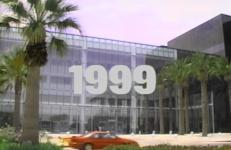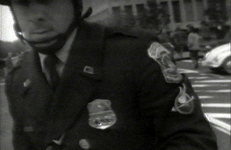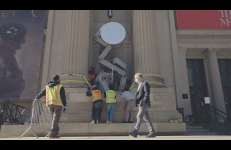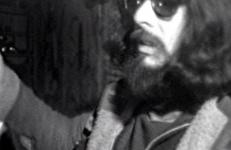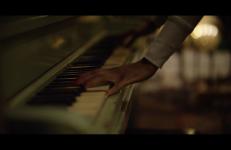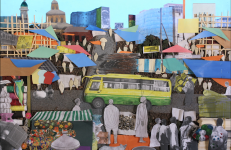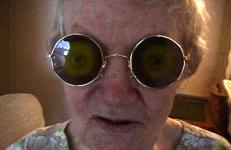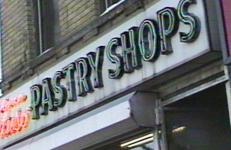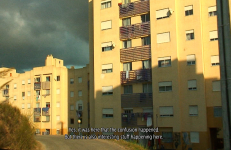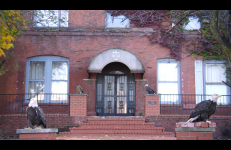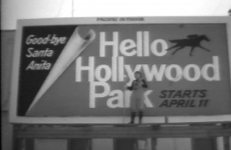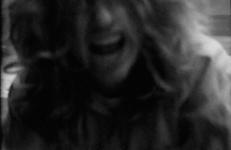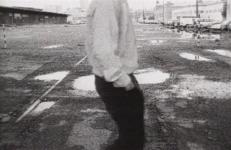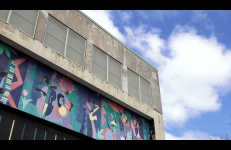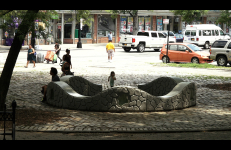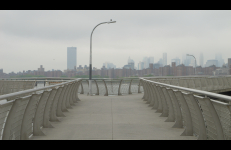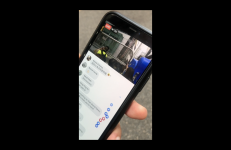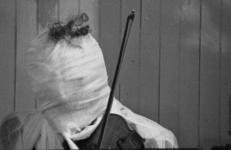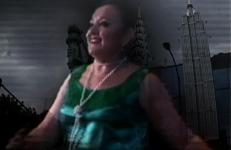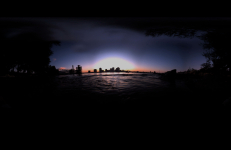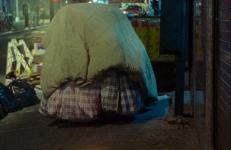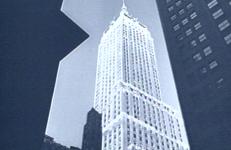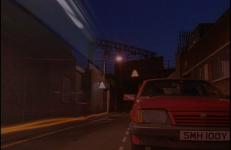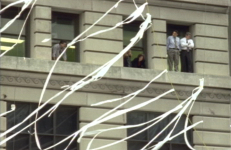Using the opening of Godard's film Alphaville as a foundation, Lord constructs a vision of the evolving global city during the last years of the 20th Century. Structured as a series of repetitions, the montage of the changing city is offset by shots of corporate Silicon Valley facades. The result is a dialectical contrast between urban and suburban space, body and mind, chaos and order, and the postmodern and the modern. Shot in Hi-8 video in Tokyo, Fukuoka City, Mexico City, Rome, San Francisco, Naples, and Los Angeles.
City
Shot over one day, this program records the events and protests in Washington DC on May Day, 1971. This was the day when one of the most disruptive actions of the Vietnam War era occurred in Washington, DC, when thousands of anti-war activists tried to shut down the Federal government in protest at the War.
A feel for the mood in the city is gained during the first half of the video with shots of the city from a moving car in traffic. Protestors, city residents, and police are captured on tape, along with exciting and moving shots of the day's actions and arrests.
Shot over one day, this program records the events and protests in Washington DC on May Day, 1971. This was the day when one of the most disruptive actions of the Vietnam War era occurred in Washington, DC, when thousands of anti-war activists tried to shut down the Federal government in protest at the War.
A feel for the mood in the city is gained during the first half of the video with shots of the city from a moving car in traffic. Protestors, city residents, and police are captured on tape, along with exciting and moving shots of the day's actions and arrests.
This film originated as an expanded portrait of artist Carol Bove as she created four monumental sculptures commissioned by the Metropolitan Museum of Art. One week after filming began, New York City went into its first pandemic lockdown. Filmed against the backdrop of the progressing pandemic, Medium evolved into a meditation on materiality and the artist as a medium through which ideas move into the world.
A Memory of Astoria, commissioned for Museum of the Moving Image, is an impressionistic portrait of the blocks surrounding the Museum in Astoria, New York. Artist Ezra Wube walked the neighborhood to observe the area’s confluence of cultures, focusing on everyday moments, sights, and sounds. He reconstituted these experiences into a poetic visual collage, inserting himself as a silhouetted observer exploring the memories of his walks.
Memory Palace is a short video grounded in the personal history of the artist. A discovery of a photo album activates memories of physical spaces, which in turn open doors to reminiscences of past family life. Inspired by the classical method of loci, the film presents a woman — singer/songwriter Alice Smith — at work in Los Angeles.
Based on Emanuel Admassu's essay Menged Merkato, an architectural analysis and historical journey of the largest open-air market in Africa, located in Addis Ababa, Ethiopia. Merkato was developed during the Italian occupation of Addis Ababa to segregate the markets of the locals and the newcomers. Unlike the earlier circular formation which centered the royal palace, Merkato was built on a grid which allowed for a dispersed flow facilitating dynamic interactions and exchanges.
The New York City summer is fueled by the sultry emanations of hot air that tumble off the tongues of potential thespians as they attempt to decipher the gastric guesswork embedded in the prose of the pre-production process. The video camera flits across the boroughs of NYC in a splash-dash sojourn of sumptuous banquets and bohemian bombast, while the down-to-earth wisdom of the seeing impaired helps to guide the protagonist into detours of wisdom befitting his putrid project.
A chance to view the upper Bronx as a mantle of whiteness cloaks its natural splendor like icing on a cake and things all blubbery bob to the surface for air and a sniff of the "good life."
Military Road is a project of visual mapping of the suburban realities of the city of Lisbon in connection to the migrant fluxes to Europe conected to de-colonization and the end of the Portuguese Empire in Africa. Military road was built around the city at the beginning of the XIX century, to defend the city from the French and English invasions.
"I brought live reptiles, birds of prey and exotic flowers to a very stereotyped and neglected section of the city of St. Louis, Missouri which suffers from from severe abandonment and despair, but also has many tranquil vacant lots where nature flourishes. I chose these birds of prey for their symbolic meaning- The bald eagle a symbol of the United States, hawks and owls are messengers. But this is not a film about St. Louis, It's about an anonymous archetype more than a specific locale. St.
Looking like a 1970’s version of “Rosie the Riveter”, Mogul takes on the persona of an artist who makes a living posting billboards on the Sunset Strip in Hollywood. As Mogul recounts her climb up the billboard “ladder”, she realizes that the only way to truly make a “name” for herself is to create her own billboard. And so she does.
Taped on Prince Street in Soho, New York City, Skip Blumberg creates a one-word performance. Shouting the word "money" over and over, he attracts the attention of New York's finest. The video crew attempt to explain to the policemen that there is no public disorder as the streets were empty when they began to tape.
The video is an unwitting early example of the reaction of the state to the use of video cameras on the streets.
This compilation features 11 of Jem Cohen's collaborations with musicians. Made on 16mm, Super 8 and Video, the works include the music of R.E.M., Gil Shaham and the Orpheus Chamber Orchestra, Void, Elliot Smith, Jonathan Richman, Miracle Legion and Olivier Messiaen.
Nightswimming
Urban parks consist of two major elements: nature and man-made forms. Parks play an important role in the urban environment, offering relief in everyday life. While parks provide green spaces, they are not natural spaces; they are highly designed. Nature and Geometry in the Park is a series of short videos that explore parks, focusing on form. Case 1 features Herbert Von King Park in the heart of Brooklyn’s Bedford-Stuyvesant neighborhood.
Urban parks consist of two major elements: nature and man-made forms. Parks play an important role in the urban environment, offering relief in everyday life. While parks provide green spaces, they are not natural spaces; they are highly designed. Nature and Geometry in the Park is a series of short videos that explore parks, focusing on form. Case 2 features Fort Greene Park in Downtown Brooklyn, which was originally the site of a fortification built for the Revolutionary War.
Urban parks consist of two major elements: nature and man-made forms. Parks play an important role in the urban environment, offering relief in everyday life. While parks provide green spaces, they are not natural spaces; they are highly designed. Nature and Geometry in the Park is a series of short videos that explore parks, focusing on form. Case 3 features WNYC Transmitter Park, a relatively new park located on the waterfront in Greenpoint, Brooklyn, which opened in 2012.
Never Rest/Unrest is a hand-held short film about the relentless political actions in Hong Kong, spanning early summer to late 2019. The experimental short is an adaptation of the artist's practice of scaling oral history, utilizing the vertical 16:9 aspect ratio as a vernacular form. Never Rest/Unrest takes up the provocation of Julio Garcia Espinosa's "Imperfect Cinema" on the potential for filmmaking that aims towards an urgent, process-driven cinema. Dominant narratives of crisis pushed by news journalism are resisted.
This is not a sight-seeing film, but a poetic journey through light and darkness reflected on the city of New York, where I often found empty spaces and times like Ma in Japanese. You do not often see the people walking on the streets or in the buildings, but you may feel the air and the light coming and going. It's not a deserted city, but a city full of energy that is there even without the people. You see the wind is blowing as the bubbles are floating over Wall Street, then up, up to the sky. The Sun sets under the Washington Bridge, where all the cars are runnin
A montage of architecture and cabaret, juxtaposing a second hand view of New York as refracted through this artist's eyes.
This title is also available on Half-Lies: The Videoworks of Ximena Cuevas.
Next Atlantis is a video/sound collaboration between composer Sebastian Currier and filmmaker Pawel Wojtasik. It premiered at Carnegie Hall on January 29th 2010 and had another performance at Philadelphia's Annenberg Center the following night, Jan 30th, 2010. American Composer's Orchestra performed the musical score both nights. In addition to the video images and live orchestra the piece utilizes a surround soundtrack of taped and electronic sounds.
Chance observations of New York's Chinatown, commissioned by the Museum of Chinese in the Americas.
"A sleepwalker's circumnavigation of one of the less homogenized parts of the city."
--Jem Cohen
No Damage is a composition made out of fragments from over 80 different feature and documentary films that show the architecture of New York City — its architectural presence as captured on film over eight decades. Lifted out of their original context and juxtaposed in groups, these scenes reveal their emotional implications: grandeur, glamour, the wake of modernism, post-modernism and, most recently, post 9/11 sentimentalism. A number of particular clips that resonate such emotions enter into a non-verbal discourse on age, status, functionality and aesthetics.
Nocturne is a 5-minute film shot entirely at night in deserted streets of London. The film attempts to find images of the city that reveal the presence of the past, or the presence of the dead, hinting at a concealed history. The deserted streets around the east end of London and Docklands reflect an echoic city filled with shadows. Nocturne is composed of long static viewpoints, each shot slowly unfolding in time as though by looking long enough the city's secrets will be revealed.
My film is a simple gathering of New York City street footage. It was shot with a spring-wound 16mm Bolex on, above, and below the streets of Manhattan and Brooklyn and includes footage of the ticker tape parade for astronaut John Glenn.




